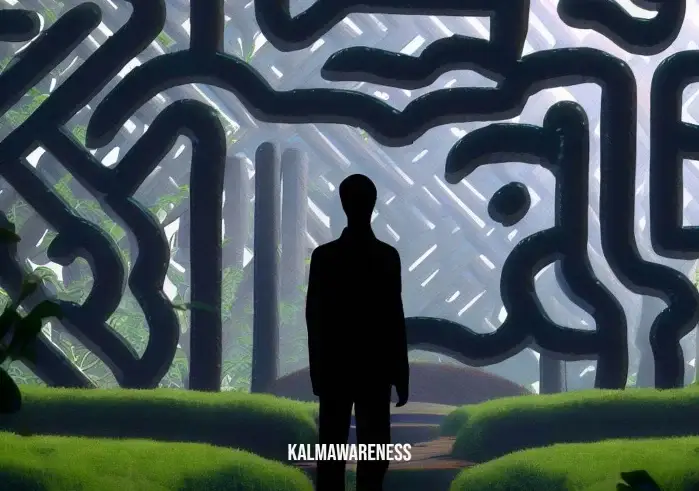Taming the Mind: Journey into Mindfulness and Inner Calm
In this ever-accelerating world, inner calm and mental discipline seem elusive. Yet, through techniques such as mindfulness and meditation, we can learn to tame our minds, fostering emotional regulation, focus, and tranquility. This article will explore the concept of taming the mind, providing insights and actionable practices to integrate into your daily routine.
Understanding the Mind
Before we delve into techniques for taming the mind, it’s important to understand the challenges we face. Our minds are wired for survival, often leading to a cycle of negative thoughts and reactions to perceived threats. We find ourselves in a state of constant stress, our minds filled with unnecessary clutter, and our focus and calmness eroded.
But what if we could change our reaction to these perceived threats? What if we could learn to respond with equanimity instead of reacting impulsively? Training our minds to respond, not react, is a pivotal step in taming the mind. It involves stepping back, observing our thoughts and emotions without judgment, and making a conscious choice about our response.
“The mind is everything. What you think you become.” – Buddha
In our journey of taming the mind, we will explore various practices that cultivate mindfulness, emotional regulation, and inner calmness. Through techniques such as Dhammakaya meditation, we can harness the power of mindfulness, focusing on inner stillness and clarity. Similarly, understanding how to sit with our emotions, without getting flustered easily, can significantly improve our emotional regulation.
Taming the Mind Through Mindfulness
Mindfulness, or the practice of being fully present in the moment, is a powerful tool in taming the mind. Whether it’s by focusing on our breath, acknowledging our thoughts and feelings, or simply being aware of the sensations in our body, mindfulness can help us cultivate a sense of calm and focus.
When we practice mindfulness, we learn to create a space between our thoughts and our reactions. This space allows us to respond thoughtfully, rather than reacting impulsively. By recognizing our thoughts as mere thoughts, we can learn to let them come and go without causing distress.
Mindfulness techniques, such as Diana Winston meditation, offer practical ways to cultivate this mindful presence. Likewise, practices like name it to tame it help us regulate our emotions by simply naming them, allowing us to observe them without getting swept away.
For those struggling with specific challenges, targeted mindfulness techniques can be particularly beneficial. For instance, meditation for negative thoughts provides tools to acknowledge and let go of destructive thought patterns, promoting a more balanced and calm mind.
As we navigate through this journey of taming the mind, it’s essential to understand that it’s not about eliminating thoughts or emotions but about developing a new relationship with them.
As you explore these concepts, you’ll learn how they form the foundations of mindfulness and how they can help you achieve a greater sense of inner calm, focus, and mental discipline. Through practical examples and targeted techniques, you’ll gain the tools to embark on your journey of taming the mind.
Invite you to continue to the next part of the article, where we delve deeper into specific practices that can help in taming the mind, the importance of self-discipline, emotional control, and much more.

Embracing Emotional Regulation: The Next Step in Taming the Mind
Understanding the value of emotional regulation is a pivotal step in our journey to tame the mind. Emotion regulation refers to the process of recognizing and managing our emotional responses. A lack of control over our emotions can lead to various negative impacts on our mental health, including anxiety, depression, and stress. When we understand and practice emotional regulation, we’re better equipped to deal with challenging situations and maintain a sense of calm and balance.
Emotional Regulation Techniques
The following are some proven techniques to help manage and regulate emotions. Not only do these techniques provide immediate relief in stressful situations, but they also help to improve overall emotional health when practiced regularly.
- Mindful Breathing: This technique is about being present in the moment and focusing on your breath. The candle and flower breathing method provides a practical application for this technique, teaching us how to calm our minds and bodies through deep, controlled breathing.
- Observing Without Judgment: This technique encourages us to observe our thoughts and emotions without judgment. Practicing this can help us to avoid reacting impulsively to our emotions. Read more about how to practice equanimity to develop this skill.
- Cognitive Reframing: This is a technique that involves changing negative or harmful thought patterns into positive ones. The name it, tame it, reframe it method offers practical guidance on how to implement this technique.
- Mindful Meditation: Regular practice of meditation can also help in emotional regulation. Explore meditation for musicians and meditation for martial arts to understand how meditation can be integrated into various aspects of our lives.
- Self-care: Prioritizing self-care and ensuring that we have healthy coping mechanisms can greatly help in managing emotions. Understanding how to not get flustered easily can be beneficial in establishing healthy self-care routines.
Emotional Regulation and Its Impact on Daily Life
Emotional regulation has profound impacts on our daily lives. The following table illustrates these impacts in various aspects of our life:
| Aspect of Life | Without Emotional Regulation | With Emotional Regulation |
|---|---|---|
| Relationships | Frequent conflicts, misunderstanding | Harmony, understanding, empathy |
| Work Environment | Stress, inefficiency, burnout | Productivity, job satisfaction, work-life balance |
| Personal Growth | Stagnation, lack of self-confidence | Confidence, continuous learning, resilience |
| Mental Health | Anxiety, depression, emotional instability | Inner peace, happiness, emotional stability |
| Physical Health | Poor sleep, frequent illness | Better sleep, improved overall health |
Incorporating Emotional Regulation into Your Routine
To truly incorporate emotional regulation into your life, it’s essential to make these practices a part of your daily routine. One way to do this is through the concept of micro-meditations. The practice of micro-meditation encourages taking short, frequent breaks throughout the day to practice mindfulness and meditation, allowing you to constantly check in with your emotional state.
By dedicating time each day to recognize and manage your emotions, you’re making significant progress in the journey of taming the mind. It might seem challenging at first, but with time and practice, it will become a natural part of your life.
Continue your exploration of taming the mind in the next part of this series. You’ll discover the essential role of self-discipline, learn how to maintain inner calmness in various situations, and understand the importance of staying composed under pressure. With each step on this journey, you’ll uncover more about your potential for peace, clarity, and resilience.

Mastering Self-Discipline: A Crucial Element in Taming the Mind
In our quest to tame the mind, another essential facet to consider is self-discipline. The mind is a complicated entity, filled with thoughts and feelings that can often lead us astray if not properly managed. In the wise words of Swami Sivananda, “An undisciplined mind is a mine of troubles.” Mastering self-discipline can help us harness these energies and guide them in a direction that aids us in our growth and wellbeing.
The Role of Self-Discipline in Taming the Mind
Self-discipline plays a critical role in taming the mind. It’s about taking control of your actions, your reactions, and, essentially, your life. Self-discipline can help you resist impulses, endure hardships, and achieve your long-term goals. This article on self-discipline and emotional control can further elucidate this vital subject.
Developing self-discipline is like building a muscle – the more you exercise it, the stronger it gets. Jim Rohn beautifully encapsulated this when he said, “We must all suffer from one of two pains: the pain of discipline or the pain of regret.” It is through continual practice and perseverance that we can truly master self-discipline.
Techniques for Developing Self-Discipline
There are several ways to foster self-discipline and incorporate it into our lives. Here are some strategies that may be helpful:
- Setting Clear Goals: Be sure about what you want to achieve. Having clear goals makes it easier to stay focused and disciplined. Use the decision-making meditation as a tool to help clarify your objectives.
- Creating a Routine: Building a daily routine can reinforce self-discipline. This guide on a calm daily routine can help you establish a structure that promotes peace and discipline.
- Practicing Mindfulness: Staying present and conscious of your thoughts and actions can aid in enhancing self-discipline. Learn more about internal attention to understand how mindfulness can support your journey of self-discipline.
- Building Resilience: Cultivate resilience to handle setbacks without losing your discipline. Insights on how to keep your composure can provide useful advice on nurturing resilience.
- Consistent Practice: Consistency is key in developing self-discipline. Make it a point to practice discipline every day, no matter how small the task may be. Read about mindful behavioral solutions for tips on how to consistently incorporate mindfulness and discipline into your everyday life.
The Dalai Lama once stated, “A disciplined mind leads to happiness, and an undisciplined mind leads to suffering.” It’s clear that self-discipline is not just a tool for achieving goals but also a pathway to contentment and inner peace.
The Impact of Self-Discipline on Mental Health
Self-discipline directly influences our mental health. It helps us control our thoughts, manage our feelings, and make healthier choices. It enables us to stick to beneficial habits like regular exercise, good sleep, and balanced diet, all of which have a positive effect on our mental health. You can learn more about the mind-body connection to understand how physical discipline can impact mental wellbeing.
Mastering self-discipline is a transformative journey, one that has the potential to bring peace, stability, and contentment. So, as we continue our exploration into taming the mind, let us remember the profound words of Buddha: “To enjoy good health, to bring true happiness to one’s family, to bring peace to all, one must first discipline and control one’s mind.”

Embracing Mindfulness and Meditation: Essential Steps in Taming the Mind
As we venture further in our journey of taming the mind, it’s time to delve into the profound world of mindfulness and meditation. Both practices encourage us to step back from the relentless cycle of thought and emotion, to immerse ourselves in the present moment, and to cultivate a sense of inner tranquility. Thich Nhat Hanh, the renowned Buddhist monk and peace activist, once said, “Mindfulness is the miracle by which we master and restore ourselves.”
Mindfulness: A Gateway to the Present
Mindfulness is the practice of paying attention to our thoughts, feelings, bodily sensations, and surrounding environment in a deliberate and non-judgmental way. This conscious awareness can be a powerful tool in taming the mind, helping us to break free from negative thought patterns and emotional reactivity. You can further explore the transformative power of mindfulness in this article on anger and mindfulness.
Jon Kabat-Zinn, a pioneer in mindfulness-based stress reduction, wisely noted, “Mindfulness is a way of befriending ourselves and our experience.” By practicing mindfulness, we create a space for ourselves to observe our experiences without judgment, allowing us to develop a deeper understanding of our minds.
The Art of Meditation
Meditation, often used in conjunction with mindfulness, is another powerful tool for taming the mind. It involves engaging in a particular focus—such as breath, a mantra, or a visual object—to enhance concentration and awareness, and to achieve mental clarity and emotional calm. For more insights into different meditation techniques, consider reading the focused attention practices article.
The revered spiritual teacher, Sri Chinmoy, once said, “Meditation gives you peace of mind without a tranquilizer. And do you know what? When you have peace of mind, the rest of the world also feels it, and receives a soothing atmosphere.”
The Intersection of Mindfulness and Meditation
Mindfulness and meditation often intersect, creating a powerful synergy that can significantly aid in taming the mind. Here are some of the ways in which they work together:
| Mindfulness | Meditation | How They Complement Each Other |
|---|---|---|
| Enhances awareness | Boosts concentration | Together, they strengthen mind’s ability to stay present and focused |
| Encourages acceptance | Promotes tranquility | Combined, they foster a sense of inner peace |
| Fosters non-judgmental observation | Encourages introspection | Together, they enhance self-understanding |
| Helps break negative thought patterns | Provides mental clarity | Combined, they support healthier thought processes |
| Promotes emotional regulation | Encourages emotional balance | Together, they nurture emotional wellbeing |
For more in-depth knowledge about the intersection of mindfulness and meditation, you can refer to the article on Dhammakaya meditation, a technique that beautifully amalgamates the two practices.
As Zen Master Thich Nhat Hanh beautifully encapsulates, “Peace can exist only in the present moment. It is ridiculous to say, ‘Wait until I finish this, then I will be free to live in peace.’ What is ‘this’? A diploma, a job, a house, the payment of a debt? If you think that way, peace will never come. There is always another ‘this’ that will follow the present one.”

Regulating Emotions: The Final Step in Taming the Mind
In the final chapter of our exploration of taming the mind, we are delving into the realm of emotional regulation. As human beings, we are wired for emotion. However, these feelings—be they joy, sorrow, anger, fear, or surprise—can sometimes run rampant, leading to impulsive actions and mental turmoil. Therefore, regulating our emotions is a crucial aspect of achieving a calm and focused mind.
As the esteemed Dalai Lama once said, “With realization of one’s own potential and self-confidence in one’s ability, one can build a better world.”
Emotional Awareness
Before we can regulate our emotions, we first need to be aware of them. This might sound simple, but in the midst of a busy day or during a moment of intense emotion, it can be surprisingly challenging. In these instances, techniques such as sitting with your emotions can be highly beneficial.
“We cannot selectively numb emotions. When we numb the painful emotions, we also numb the positive emotions.” – Brené Brown
Emotional Acceptance
Once we’ve identified our emotions, the next step is to accept them without judgment. This acceptance is a form of self-compassion and understanding, acknowledging that we are human beings who experience a broad range of emotions. The technique of name it to tame it can be a powerful tool for this purpose, as it encourages us to objectively identify our emotions.
“The greatest gift you can give yourself is emotional acceptance and understanding. Let the emotions flow through you, and just be with them.” – Tony Robbins
Emotional Management
After gaining awareness and acceptance of our emotions, we can then work on managing them. This can be achieved through a variety of techniques such as deep breathing, progressive muscle relaxation, meditation, and mindfulness. The article on how to keep your composure offers valuable insights into maintaining calmness in challenging situations.
“The key to managing your emotions is to take control of your thoughts.” – Jim Rohn
Emotional Expression
The final piece of the emotional regulation puzzle is the healthy expression of emotions. This doesn’t mean that we act on every emotion we feel but rather that we express our feelings in a respectful and constructive manner. The article on controlling self-reflection can help you understand how self-reflection plays a crucial role in taming the mind and effectively expressing emotions.
“Holding in emotions is like holding in a sneeze. At some point, it’s going to come out, and it won’t be pretty.” – Mel Robbins
In conclusion, taming the mind is a journey of self-discovery and growth. Through mindfulness, meditation, and emotional regulation, we can cultivate a sense of inner peace and focus, navigating life’s ups and downs with grace and resilience. The journey may not always be easy, but the rewards are truly worth it.
“Between stimulus and response, there is a space. In that space is our power to choose our response. In our response lies our growth and our freedom.” – Viktor E. Frankl
This marks the end of our comprehensive guide to taming the mind. We hope that this journey has been enlightening, providing you with practical insights and techniques to nurture a calmer, more focused mind. As the journey continues, we invite you to explore the various articles and resources on our website to deepen your understanding and practice of mindfulness, meditation, and emotional regulation. Remember, the power to tame the mind lies within you.

Taming the Mind: Lightening the Load and Looking Forward
As we come to the final chapter of our journey to taming the mind, we lighten our load and focus on optimism, resilience, and cultivating an ongoing mindfulness practice. Life presents us with constant challenges. At times, the mental turbulence seems overwhelming, but remember, you have embarked on a path of learning and self-growth. You’ve honed your skills in mindfulness, emotional regulation, inner calmness, focus, and mental discipline. Now, it’s time to look forward to what awaits.
Building Resilience
Resilience is the ability to withstand adversity and bounce back from difficult life events. It’s not about avoiding challenges but learning to tackle them head-on, coming out stronger on the other side. The article on always feeling comfortable provides an excellent framework to build resilience.
“I can be changed by what happens to me. But I refuse to be reduced by it.” – Maya Angelou
Fostering Optimism
Maintaining an optimistic outlook can have profound effects on our mental well-being. Optimism doesn’t mean ignoring life’s difficulties but choosing to focus on the potential for positive outcomes despite the hardships. Here’s an informative guide on how not to get flustered easily, a key trait of optimistic individuals.
“Optimism is a happiness magnet. If you stay positive, good things and good people will be drawn to you.” – Mary Lou Retton
Cultivating Mindfulness
Incorporating mindfulness into your daily routine can be a game-changer. It enables you to stay present, focused, and balanced amidst life’s chaos. Our guide on micro-meditation can help you infuse mindfulness into your daily activities.
“Mindfulness isn’t difficult; we just need to remember to do it.” – Sharon Salzberg
Looking Forward: The Journey Continues
Congratulations on reaching the end of this comprehensive guide on taming the mind! We hope it’s been a fulfilling journey, providing you with practical tools and insights to cultivate inner peace and focus. Remember, this is not the end but the beginning of your continued exploration of mindfulness and emotional regulation.
“The journey of a thousand miles begins with one step.” – Lao Tzu
As we conclude our exploration, we extend a warm invitation for you to continue to explore, learn, and grow with us. Visit the Kalm Awareness website regularly for more guides, articles, and resources on mindfulness, meditation, and emotional regulation. Wishing you inner peace, focus, and a tamed mind as you continue your journey. Remember, the journey to taming the mind is ongoing, but every step you take is a step toward a calmer, more mindful you.





